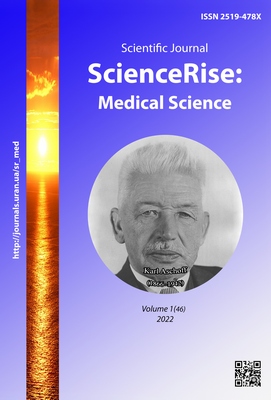Predictor properties of indicators of undifferentiated connective tissue dysplasia in children with gastroesophageal reflux for prediction of the development of heart rhythm and conduction disorders
DOI:
https://doi.org/10.15587/2519-4798.2022.253073Keywords:
undifferentiated connective tissue dysplasia, gastroesophageal reflux, arrhythmias, children, predictor propertiesAbstract
The aim: to improve the early diagnosis of cardiac arrhythmia and conduction disorders in children with gastroesophageal reflux by studying the predictor properties of indicators of undifferentiated connective tissue dysplasia in this category of patients.
Materials and methods. We examined 56 children aged 8 to 18 years, with an average age of 14.93±2.62 years, of which 28 children with gastroesophageal reflux in combination with cardiac arrhythmias and conduction disorders were divided into group I, and 28 children with only gastroesophageal reflux without heart rhythm and conduction disturbances – into group II (control). All examined patients underwent clinical and instrumental studies (electrocardiography, 24-hour ECG Holter monitoring, esophagogastroduodenoscopy and PH-metry) and an assessment of the phenotypic signs of undifferentiated connective tissue dysplasia according to the criteria of T. Milkovskaya-Dimitrova and A. Karkashov.
Results. When analyzing the predictor properties of indicators of undifferentiated connective tissue dysplasia for predicting the development of cardiac arrhythmias and conduction disorders in children with gastroesophageal reflux, it was found that scoliotic posture had very high predictor properties (I=5.99), а high growth (I=1.94) and a short upper lip (I=1.17) – high, dysplastic tooth growth (I=0 .6) – moderate, and an abnormal shape of the auricles – low ones (I=0.27).
Other indicators of undifferentiated connective tissue dysplasia did not have predictive properties at all: joint hypermobility (I=0.22), total number of signs of undifferentiated connective tissue dysplasia (I=0.11), asthenic type of constitution (I=0.11), flat feet (I=0.08), refractive errors (I=0.05), deviated septum of nose (I=0.03), dilated bridge of the nose (I=0.01), short neck (I=0.01).
The mean value of the prognostic significance of indicators of undifferentiated connective tissue dysplasia was high (І̅=1,99).
Conclusions. It was found that the mean value of the prognostic significance of indicators of undifferentiated connective tissue dysplasia was high (І̅=1,99).
It was determined that arrhythmias and cardiac conduction disturbances in children with gastroesophageal reflux are associated with the presence of a scoliotic posture (І=5,99), high growth (І=1,94), dysplastic growth of teeth (І=0,6); in the absence of a short upper lip (І=1,17) and an abnormal shape of the auricles (І=0,27)
References
- Blaufox, A. D. (2018). Irregular heart rhythm (arrhythmias) in children. Waltham.
- Gonchar, М. О., Muratov, H. R., Strashok, O. І., Haіn, M. A., Strelkova, M. І.; Senatorova, G. S. (Ed.) (2018). Takhiarytmii u ditei. Kharkіv, 84.
- Osteraas, N. (2021). Neurologic complications of brady-arrhythmias. Heart and Neurologic Disease. Elsevier, 163–174. doi: http://doi.org/10.1016/b978-0-12-819814-8.00006-8
- Bagnall, R. D., Singer, E. S., Tfelt-Hansen, J. (2020). Sudden Cardiac Death in the Young. Heart, Lung and Circulation, 29 (4), 498–504. doi: http://doi.org/10.1016/j.hlc.2019.11.007
- Drago, F., Battipaglia, I., Di Mambro, C. (2018). Neonatal and Pediatric Arrhythmias: clinical and electrocardiographic aspects. Cardiac Electrophysiology Clinics, 10 (2), 397–412. doi: http://doi.org/10.1016/j.ccep.2018.02.008
- Rohit, M., Kasinadhuni, G. (2020). Management of Arrhythmias in Pediatric Emergency. The Indian Journal of Pediatrics, 87 (4), 295–304. doi: http://doi.org/10.1007/s12098-020-03267-2
- Lakshmanadoss, U. (Ed.) (2020). Differential Diagnosis of Chest Pain. BoD–Books on Demand, 98. doi: http://doi.org/10.5772/intechopen.78875
- Rees, C. J., Cantor, R. M., Pollack, Jr. C. V., Riese, V. G.; Pollack, Jr. C. (Ed.) (2019). Gastroesophageal Reflux Disease. Differential Diagnosis of Cardiopulmonary Disease. Cham: Springer, 441–449. doi: http://doi.org/10.1007/978-3-319-63895-9_30
- Lukianenko, N. S., Petritsa, N. A., Kens, K. A. (2015). Place of undifferentiated connective tissue dysplasia in childhood pathology (literature review). Zdorove rebenka, 2, 80–85. Available at: http://nbuv.gov.ua/UJRN/Zd_2015_2_18
- Zikriyaevna, S. G. (2017). Special features of clinical and functional disorders in patients with undifferentiated connective tissue dysplasia. European science review, 3-4, 72–74.
- Yagoda, A. V., Novikova, M. V., Gladkikh, N. N. (2015). Faktory riska prognosticheski znachimykh narusheniy serdechnogo ritma pri displazii soedinitelnoy tkani. Arkhiv vnutrenney meditsiny, 1, 60–63.
- Herasymova, O., Filonova, T. (2021). Undifferentiated connective tissue dysplasia as a predictor of heart rate disorders in combination with gastroesophageal reflux disease in children. ScienceRise: Medical Science, 4 (43), 41–45. doi: http://doi.org/10.15587/2519-4798.2021.238132
Downloads
Published
How to Cite
Issue
Section
License
Copyright (c) 2022 Oksana Herasymova, Oksana Apanasenko

This work is licensed under a Creative Commons Attribution 4.0 International License.
Our journal abides by the Creative Commons CC BY copyright rights and permissions for open access journals.
Authors, who are published in this journal, agree to the following conditions:
1. The authors reserve the right to authorship of the work and pass the first publication right of this work to the journal under the terms of a Creative Commons CC BY, which allows others to freely distribute the published research with the obligatory reference to the authors of the original work and the first publication of the work in this journal.
2. The authors have the right to conclude separate supplement agreements that relate to non-exclusive work distribution in the form in which it has been published by the journal (for example, to upload the work to the online storage of the journal or publish it as part of a monograph), provided that the reference to the first publication of the work in this journal is included.









